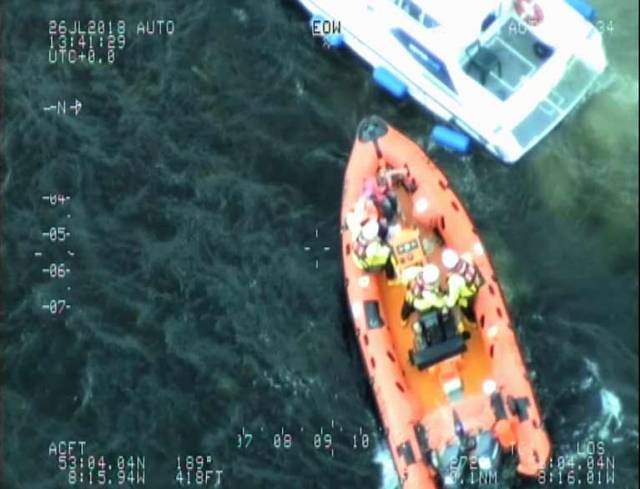At 2.12pm today Lough Derg RNLI to launched following a Mayday relay from Valentia Coast Guard to assist two people reported to be in the water after their 28ft–cruiser was 'taking on water and sinking'.
Valentia Coast Guard gave co-ordinates to the lifeboat, which located the casualty vessel in Cloondevaun Bay, at the northeastern shore of Lough Derg. The Irish Coast Guard Search and Rescue helicopter, Rescue 115 lifted off from their base in Shannon and was also in attendance. Additional RNLI shore crew and lifeboat crew came to the Station to provide assistance.
Winds were southerly, Force 5 gusting 6, with large waves forming. Visibility was good.
The Lifeboat, with helm Eleanor Hooker, Ger Egan and Mags Ryan on board arrived on scene at 2.33pm. The Irish Coast Guard Search and Rescue helicopter, Rescue 115 was overhead and monitoring the casualty vessel, which was now aground on rocks, and with both of its passengers back on board.
As Cloondevaun Bay has sudden shallows and rocks, the lifeboat approached with caution, with an RNLI volunteer taking soundings. Given the weather and the condition of the cruiser, the lifeboat volunteers took both casualties on to the lifeboat and away from immediate danger.
The crew assessed the casualties, an elderly couple on holidays from overseas and with little English, and found them to be well. Both were wearing their lifejackets. Once the lifeboat was in safe water, Rescue 115 departed the scene and returned to their base at Shannon.
The lifeboat took the couple to Terryglass Harbour, where they were given shelter, tea and dry clothes by people at berth in the harbour. RNLI shore-crew back at the Boathouse made further arrangements for the couple.
The lifeboat returned to station and was ready for service again at 5pm.
Liam Maloney, Lifeboat Operations Manager Lough Derg RNLI, says 'it's best to stay with your vessel and only get into the water as a last resort’. He advises boat users, ‘whilst navigating to your next mark, always check the marker astern of you to make you are not drifting into shallow water.’































































